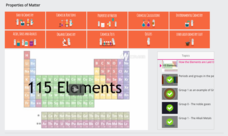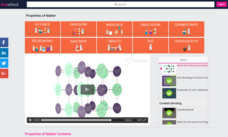PBS
The 3 Phases | Phases of Matter | UNC-TV Science
Explore the states of matter without the mess or expensive equipment in a compact, informative activity. Scientists watch as the narrator explains the three states of matter using a glass of ice and soda in an animated video that...
PBS
Phase Changes | Phases of Matter | UNC-TV Science
Take an energetic ride through the phase changes of a water molecule in a compact activity. Young scientists learn about the phases of matter and discover the role of thermal energy in governing phase changes while watching a short...
Crash Course Kids
Part(icles) of Your World
Learn about the states of matter with an entertaining physical science video. With captioned explanations and real-world examples of changes states of matter, the video is an excellent addition to your lesson or homework assignment.
Bozeman Science
Matter
In 1924, Bose and Einstein predicted a fifth state of matter. The prediction proved to be true in 1995 and is referred to as the Bose-Einstein condensation. This video discusses the concept of matter, all five states of matter, and what...
Crash Course
A Brief History of the Universe
No one was actually there to see the birth of the universe, but years of collaboration between physicists and mathematicians allow us to glimpse all but a fraction of a second of it. A narrated journey shows the phase changes early...
Teacher's Pet
Phase Diagrams
This is one phase you'll enjoy going through with your class! Young chemists discover the components of phase diagrams in a video lesson. The narrator discusses temperature and pressure, then shows how their interaction affects the state...
Bozeman Science
PS1A—Structure and Properties of Matter
It's time we get to the heart of the matter! Explore standard PS1A in an informative video. The narrator guides viewers through the basic ideas of the structure and properties of matter. then discusses helpful strategies for...
Curated OER
Phase Diagrams
In his previous videos, Sal shows students how to calculate how much energy is needed to change various amounts of water from state to state when the atmospheric pressure is constant. In this video, he shows students how to use phase...
Fuse School
Ionic Bonds
Isn't it ionic that when atoms steal from each other, we call it bonding? A brief video explains ionic bonds, details what an ion is, how they are attracted, and the type of bond formed. The first video in a six-part series on ionic...
Fuse School
Properties of Ionic Substances
Scholars learn about ionic substances, but how often do they encounter them in their daily lives? The final video in a six-part series explains ionic substances are more common that most people realize. The narrator discusses the...
Fuse School
How the Elements are Laid Out in the Periodic Table
When scientists confirm new elements, do these elements always fit in on the periodic table where scientists expect? The second video in a series of 15 discusses how the elements are organized on the periodic table. The resource includes...
Fuse School
Group 2 - Alkaline Earth metals
Alkaline earth metals each burn with a different-colored flame. The seventh video in a 15-part series focuses on the alkaline earth metals in group two. It discusses their properties and how they vary based on periods, explains the...
Fuse School
What are Emulsions?
Let's stick together! Pupils become immersed in the world of emulsifiers as they complete part 11 of a 14-part series of videos discussing the states of matter. The narrator describes common emulsions and how emulsifiers work to hold all...
Fuse School
Solubility Curves
How do chemists use solubility data? Chemistry scholars learn the usefulness of solubility curves and how they are generated. The seventh part in a series of 14 discusses the solubility rules, plotting solubility data, and how pupils can...
Fuse School
Element, Mixture or Compound
Don't get mixed up about the differences between elements, mixtures, and compounds! Part one of a six-part series discussing these important classifications of substances illustrates simple tests one can perform to determine a material's...
Fuse School
Group 1 - The Alkali Metals
People use alkali metals, such as lithium, for many commercial purposes. The sixth video in a 15-part series covers the alkali metals. It explains the properties they share, how to handle them safely, and how the rate of reactions change...
Fuse School
Group 7 -The Halogens
The eighth video in a 15-part series focuses on the halogen group on the periodic table. It covers the valence electrons, the common reactions, and the uses for these elements. It also offers ideas for experiments to show reactivity.
Fuse School
Reactions of Halogens
Did you know that a halogen reaction actually creates household bleach? The ninth video in a 15-part series limits itself to the reactions of halogen elements. It uses multiple examples of the unusual reactions from this group including...
Fuse School
Properties of Hydrogen
Hydrogen is the most abundant element in the universe. The 12th video in a 15-part series on the periodic table of elements focuses on hydrogen. It describes its role in the universe, how it appears in nature, how we use it in...
Fuse School
Properties of Oxygen
Oxygen makes up 21 percent of Earth's atmosphere. The 13th video in a series of 15 discusses the properties of oxygen. It highlights the importance of it for respiration and corrosives. It goes on to mention the down sides of oxygen such...
Fuse School
Properties of Nitrogen
Manufacturers package foods using nitrogen to help preserve freshness and prevent bacteria from growing. The 14th video in a 15-part series discusses the properties of nitrogen. It has many uses in industry, research, and health, and the...
Fuse School
Giant Ionic Structures/Lattices
Ionic compounds don't exist as individuals; they only exist as a small part of an ionic lattice. The fourth video in a series of six discusses how the lattices form. It explains the attraction of ions and the common properties of these...
Fuse School
Conductors and Non-Conductors
To conduct or not to conduct ... that is the question! The sixth and final video in a series depicting elements, mixtures, and compounds digs deeper into the concept of conductivity. Pupils learn how the arrangement of electrons within a...
Fuse School
The Atom: Part 1
Learn the ins and outs of the particles we call atoms. A thorough video lesson describes the atom as a building block. The instructor discusses the periodic table as a reference to atoms and then explains the parts of the atom in detail.
Other popular searches
- Liquids Solids and Gases
- Solids Liquids Gases Quiz
- Matter Solids Liquids Gases
- Science Solids Liquids Gases
- Liquids Solids Gases
- Nature Liquids Solids Gases
- Liquids, Solids and Gases

























